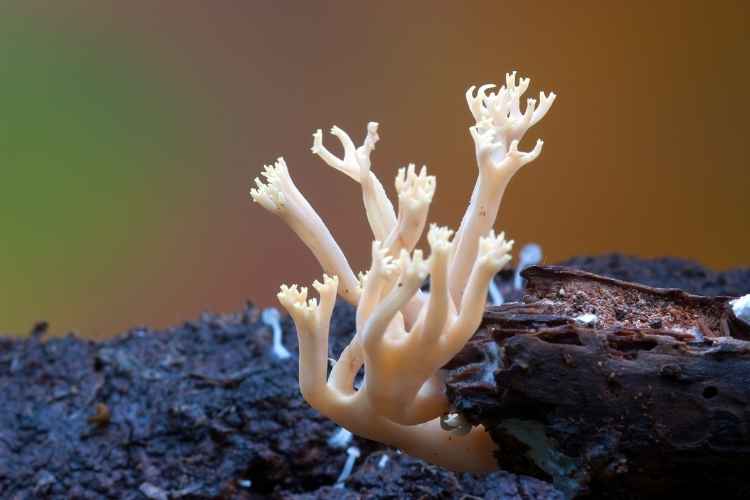In this blog we are going to tell you about Coral Mushrooms, so read this blog carefully to get the complete information. Learn all about Coral Mushrooms — their types, nutritional benefits, and how to identify them safely. Discover how these unique fungi contribute to health and how to cook them properly.
Crown-Tipped Coral mushrooms, also known as Artomyces pyxidatus in botanical terms, are a foraged variation that is not currently being grown. They are edible and named for their coral-like appearance. Crown-Tipped Coral-type fungus come in a variety of varieties, but coral mushrooms are one of the few that can be found growing on dead or downed hardwoods, particularly aspen, oak, poplar, and willow trees. In this article, we will discuss all important details regarding Edible Coral Mushrooms.
About Coral Mushrooms and their taste
Crown-Tipped Coral mushrooms have extremely short stems with very thin branches extending upward. They are tiny to medium in size, measuring 2 to 8 centimeters in diameter and 5 to 12 centimeters in length. The fruiting body initially has a variety of colors, including light cream to tan, and as it ripens, it turns more yellow and takes on a faint pink tinge. Each smooth-looking tubular branch is crowned with a tiny depression encircled by three to six points, giving it a characteristic crown-like appearance. The whole mushroom is rather delicate, but the branching stalks have a strong feel. Crown-Tipped Coral mushrooms are sensitive and delicate, smell earthy, and taste mildly woodsy with a faint peppery aftertaste.
Seasons of Coral Mushrooms
From early summer through late fall, crown-tipped coral mushrooms are accessible. Crown-Tipped Coral mushrooms are widely distributed throughout the temperate parts of the Northern Hemisphere and were first identified by Swedish botanist Elias Magnus Fries in 1821. Crown-Tipped Mushrooms are currently available at farmers markets and specialty stores in the United States, mostly east of the Rocky Mountains, as well as in Europe, China, Russia, Costa Rica, and Mexico.
RELATED – Difference Between BMI and Body Fat: Know the differences in detail!
Facts about Coral Mushrooms
- Crown-Tipped Coral mushrooms, also known as Artomyces pyxidatus in botanical terms, are a foraged variation that is not currently being grown. They are edible and named for their coral-like appearance.
- Crown-Tipped Coral-type fungus come in a variety of varieties, but coral mushrooms are one of the few that can be found growing on dead or downed hardwoods, particularly aspen, oak, poplar, and willow trees.
- They belong to the “clavarioid fungus” group and are frequently referred to as “Candleabra mushrooms,” along with other visually comparable species.
- When hunting for this kind, extreme caution should be exercised because many closely related species are poisonous and inedible.
- The only forms of edible Crown-Tipped Coral mushrooms are white, beige, or yellow; stay away from mushrooms with vibrant colors.
- Crown-Tipped Coral mushrooms are popular for their unique shape and are frequently used as a garnish for soups and seafood meals when acquired from a trustworthy vendor.
Nutrition Value
Protein, potassium, and trace levels of copper, magnesium, and calcium are all present in crown-tipped coral mushrooms. Additionally, they have antimicrobial and antioxidant effects in addition to vital amino acids.
Applications of Coral Mushrooms
- Crown-Tipped Coral mushrooms can be eaten raw, although they are usually cooked because they can irritate some people’s stomachs. The mushrooms must be properly cleaned as dirt can become trapped between the tiny points at the tip of each stalk and between the branches.
- They must be disassembled and stirred in a bowl of water before washing. Crown-Tipped Because they are fragile and easily wilt when cooked, coral mushrooms are frequently used as a garnish at the end of soups, stews, and stir-fries.
- Additionally, they can be sautéed and served with fish or seafood as a play on coral in an under-the-sea concept, gently battered and fried to serve as an appetizer, or pickled and saved for later use.
- Crown-Tipped Coral Mushrooms go great with a variety of vegetables and meats, including lettuce, bok choy, snap peas, green beans, cherry tomatoes, vinaigrette, miso soup, tofu, soy sauce, and mirin, as well as seafood such as white fish, prawns, shrimp, and crab.
- When kept in the refrigerator in a paper bag for a few of days, they will last for up to six weeks if pickled.
RELATED – How to Stop Grinding Your Teeth at Night
FAQs:
What are Coral Mushrooms?
Coral Mushrooms are edible fungi known for their coral-like shape and delicate texture, often found in forests during rainy seasons.
Are Coral Mushrooms edible?
Yes, many varieties are edible and nutritious, but some can be mildly toxic — always ensure proper identification before eating.
What are the health benefits of Coral Mushrooms?
They are rich in antioxidants, vitamins, and minerals that support immunity, improve digestion, and promote overall health.
How do you cook Coral Mushrooms?
They can be sautéed, stir-fried, or added to soups and stews. Always clean them gently and cook thoroughly.
Where can you find Coral Mushrooms?
Coral Mushrooms are found in moist forest areas, growing on decaying wood or soil rich in organic matter.
How to identify edible Coral Mushrooms?
Look for firm, non-slimy clusters with a pleasant smell and avoid species with a bitter taste or unusual color patterns.
Conclusion
Elias Magnus Fries, the scientist credited with giving the Crown-Tipped Coral mushroom its name and making the discovery, was known to many of his contemporaries as “the Linnaeus of Mycology.” His main contribution to the field of mycology was the improvement of methods for identifying various genera and species. He was also the first to use spore color as a foundation for dividing gilled mushrooms into subgroups.
We Hope this blog is sufficient enough to provide the information about Coral Mushrooms. Thanks for reading this blog.

